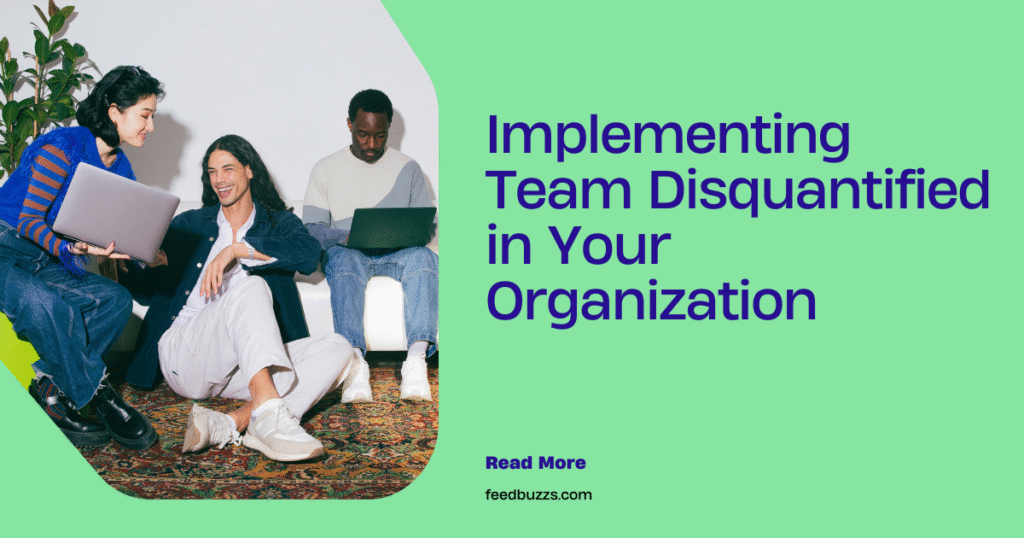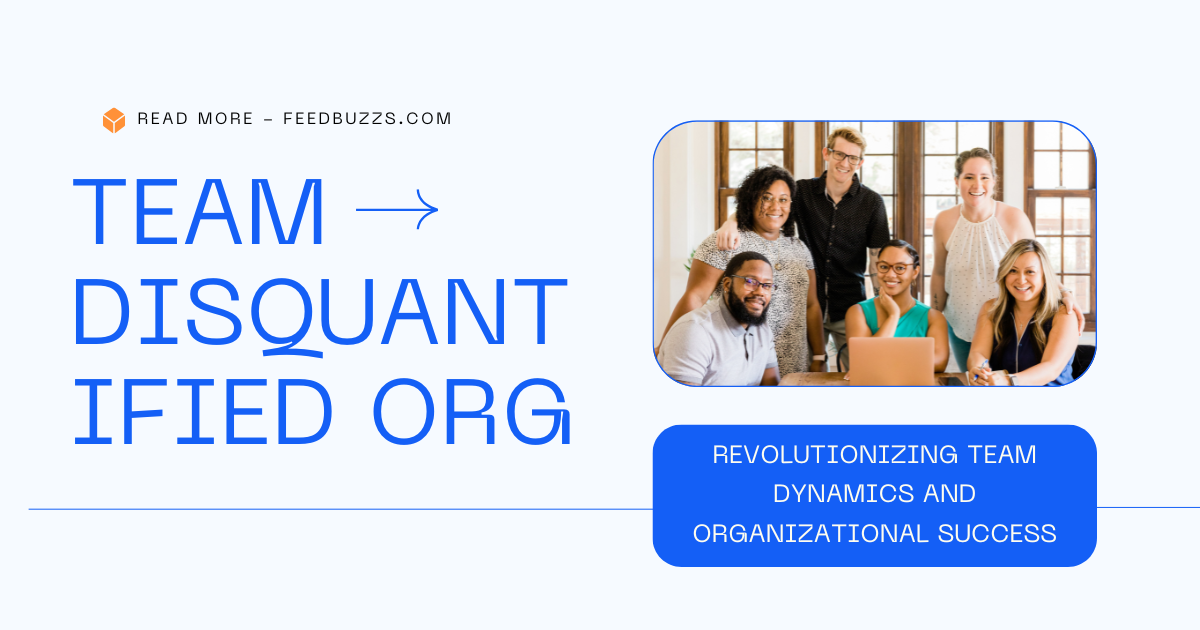In today’s fast-paced, ever-evolving business landscape, organizations are constantly seeking innovative ways to enhance team performance, foster collaboration, and drive sustainable results. One groundbreaking concept gaining momentum is team disquantified-a transformative approach that challenges traditional team structures by focusing on skill-driven, flexible, and outcome-oriented team formations. This article dives deep into the team disquantified philosophy, its practical applications, benefits, and how it can empower your organization to thrive in the digital age.
What is Team Disquantified and Why It Matters
The term team disquantified reflects a paradigm shift in how teams are formed, managed, and evaluated. Unlike conventional models that rely heavily on rigid hierarchies, fixed roles, and numeric performance metrics, the disquantified approach embraces fluidity, contextual leadership, and a balanced mix of quantitative and qualitative assessments. It recognizes that not every valuable contribution can or should be reduced to numbers, and that true team effectiveness stems from leveraging diverse skills and dynamic collaboration.
For managers, team leaders, and HR professionals grappling with stagnant productivity, poor engagement, or siloed departments, understanding team disquantified offers a fresh blueprint to build agile, motivated, and high-performing teams that can adapt to complex challenges quickly and efficiently.
Understanding Team Disquantified: Core Principles and Philosophy

Breaking Down Traditional Hierarchies
Traditional organizational structures often emphasize fixed roles, seniority-based leadership, and standardized performance metrics. While these have their place, they can also stifle creativity, slow decision-making, and limit the full potential of diverse talent pools.
The team disquantified model rejects this rigidity by:
- Forming teams based on complementary skills and project needs rather than job titles or departments.
- Distributing leadership dynamically, allowing different members to lead based on expertise and context.
- Focusing on outcomes and collaboration quality over mere process adherence or numeric targets.
- Encouraging cross-functional cooperation without bureaucratic barriers.
Quantification vs. Disquantification: A Balanced Approach
Disquantification does not mean abandoning measurement altogether. Instead, it advocates for a nuanced approach where organizations discern which aspects of team performance are best measured quantitatively and which require qualitative insights.
This prevents the common pitfall of “measuring what’s easy instead of what matters,” ensuring that team contributions such as creativity, problem-solving, and interpersonal dynamics receive proper recognition alongside productivity metrics.
Implementing Team Disquantified in Your Organization

Step 1: Assess Current Team Dynamics and Capabilities
Begin by conducting a thorough analysis of existing team structures, workflows, and pain points. Identify where rigid roles or ineffective communication hamper productivity or innovation.
Step 2: Map Skills and Expertise
Create a detailed inventory of employee skills, experiences, and interests. Advanced digital platforms can assist in matching these skills to project requirements, enabling the formation of optimized, complementary teams.
Step 3: Embrace Fluid Leadership
Establish protocols that allow leadership roles to shift based on situational needs and expertise. This flexibility fosters empowerment and accountability across all team members.
Step 4: Develop Transparent, Outcome-Focused Metrics
Design performance evaluations that balance quantitative data (e.g., project completion rates, efficiency) with qualitative feedback (e.g., collaboration quality, innovation impact). This holistic view supports continuous improvement without reducing team members to mere numbers.
Step 5: Invest in Communication and Collaboration Tools
Robust digital infrastructure is crucial for supporting dynamic team formations and seamless information sharing. Tools that facilitate real-time collaboration, documentation, and feedback loops are essential.
Benefits of the Team Disquantified Model
Enhanced Agility and Innovation
Organizations adopting the team disquantified approach report significantly higher adaptability to market changes and disruptions. By assembling teams with precisely the right mix of skills for each challenge, they reduce bureaucratic friction and accelerate problem-solving.
Improved Talent Utilization and Employee Satisfaction
This model allows individuals to contribute across a broader range of initiatives aligned with their unique skills, leading to:
- A 42% increase in employees feeling they can fully utilize their skill sets.
- A 28% improvement in talent retention.
- A 53% growth in cross-functional skill development.
Cost Efficiency and Resource Optimization
By matching resources accurately to project needs and minimizing overhead from rigid structures, organizations can operate more economically without sacrificing quality.
Real-World Example: The US Olympic 4×100 Meter Relay Team
A poignant illustration of the importance of team cohesion over individual talent is the US men’s Olympic 4×100 meter relay team. Despite having some of the fastest sprinters globally, the team struggled with baton exchanges, leading to disqualification at the 2024 Olympics. This highlighted that assembling top performers without sufficient team practice and coordination undermines success-a core lesson that team disquantified addresses by prioritizing collective dynamics over individual prowess3.
Common Misconceptions About Team Disquantified
- Myth: Teams need only top talent in every role to succeed.
Fact: Fit-for-purpose talent and complementary skills matter more than having all “superstars.” Team dynamics and collaboration are critical. - Myth: Measurement should be abandoned in disquantified teams.
Fact: Balanced measurement combining quantitative and qualitative metrics is essential to capture true performance. - Myth: Leadership must be fixed to one person.
Fact: Leadership can and should be fluid, shifting based on expertise and context.
Conclusion
The team disquantified model offers a revolutionary framework for organizations seeking to break free from outdated hierarchies and rigid performance metrics. By focusing on skill-driven, flexible teams with fluid leadership and balanced evaluation, companies can unlock unprecedented levels of agility, innovation, and employee satisfaction.
If your organization is ready to evolve, explore the team disquantified org approach to build resilient teams that thrive in complexity and change.
FAQs
Q1: What exactly does “team disquantified” mean?
A1: It refers to forming and managing teams based on skills and outcomes rather than fixed roles and numeric metrics, balancing quantitative and qualitative performance measures.
Q2: How does a team disquantified org differ from traditional organizations?
A2: It breaks down rigid hierarchies, promotes fluid leadership, and forms teams dynamically based on project needs and expertise rather than titles or departments.
Q3: Can team disquantified improve employee satisfaction?
A3: Yes, by allowing employees to use their full skill sets and participate in diverse projects, it significantly boosts engagement and retention.
Q4: What challenges might organizations face when adopting this model?
A4: Challenges include shifting leadership mindsets, investing in new communication tools, and developing balanced performance metrics that capture both quantitative and qualitative aspects.
Q5: Are there industries where team disquantified works best?
A5: While beneficial across sectors, it is especially effective in fast-changing industries like tech, finance, and creative fields where agility and innovation are critical.
Q6: How can I start implementing team disquantified in my company?
A6: Begin with a skills assessment, map capabilities, adopt fluid leadership practices, and invest in collaborative technologies to support dynamic team formation.
Q7: Where can I learn more about team disquantified?
A7: Visit resources like Disquantified.org, and explore articles on modern team management and organizational psychology for deeper insights.
Read More: Qoruv.com Architect App | Tung Tung Tung Sahur | Crazy Cattle 3D
